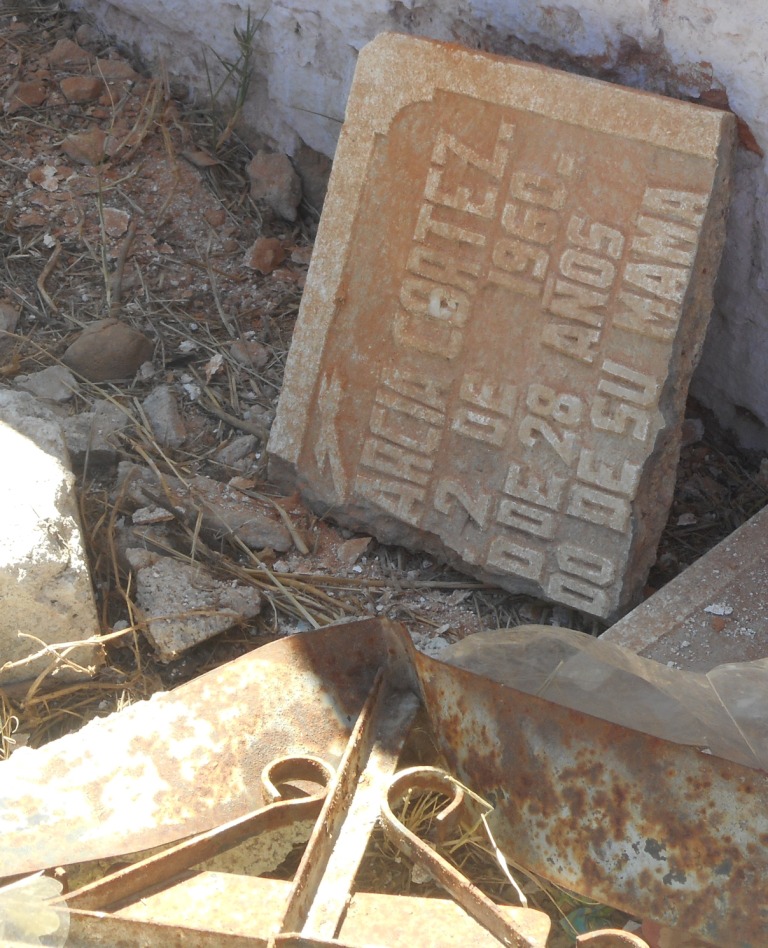Following the largest reception of American visitors for Day of the Dead we’ve ever experienced I was pondering what generated the most interest on the cemetery tours. In person, I’m normally more amazed by some of the personal stories shared as we all have death in common. On social media, it is the notion of tomb taxes that drive many Americans and Canadians crazy.
I post a lot of articles and photos that are either explaining local history and culture, or just local silly
stuff. The photos that get the most reactions are when I feature a coffin having been removed for the
former resident’s descendants’ not paying the tomb tax.
Last month, among the now dead Day of the Dead flowers, was a particularly lovely coffin ready to be hauled off as trash. Normally the coffins are rusted and twisted by the acid of decaying body fluids. This one was straight as an arrow in a pretty shade of aqua featuring multiple dollar bill sized paintings along the side that aged really well underground. As one writer on social media stated “I’d dumpster dive for that coffin and turn it into a coffee table I’d keep blankets in.”
Frankly I’ve never opened an unearthed casket for fear of both bacteria and vampires and can’t imagine storing blankets I’d want to snuggle in placed in one.
For us from the North, our tomb is our final resting place (as in “Plenty of time to rest in the grave.”) It is where we lie for eternity in cemeteries outside of town that a century ago were designed to be bucolic places for a Sunday picnic. The same cemeteries where my kids learned to ride bikes without traffic and my Mom taught me how to drive knowing anyone I hit was already dead.
Much earlier in time, on farms, there was a front room to the house used to place bodies of the dead
before burial, known as the Funeral Parlor. Later shortened to simply Parlor, where one received guests during funerals. Following World War 2 no one wanted to be reminded of death in their suburban track housing and the phrase Living Room was born.
When the Guadalupe cemetery here in San Miguel first opened you bought your burial real estate and it was your’s for eternity. Well, your’s and any relative that died at least seven years after you that wanted to bunk with you. (Seven years was for health reasons as human cells regenerate, when living, every seven years.)
Then the cemetery started to fill up and the notion of tomb taxes was born. Basically every five years
someone has to pay your tomb’s real estate tax at the same government office I pay the taxes for my
house at. Like with my home, if taxes aren’t paid, the occupants get evicted and new folks can move in.
In the time it takes me to tour the cemetery a monument can be torn down, casket removed, remains (if any) place in a paupers’ grave and the real estate ready for the next resident. This notion drives folks from the US and Canada to distraction. Mexicans not so much.
If you believe your birth day is when you die and go to eternal life, and you’ve no descendants to bring you back for Day of the Dead or pay your tomb taxes, your bones are no more important to you than your old shoes. You’re in Heaven and no longer need to schlep back here for Day of the Dead so all is great in your world.
The notion of not having an eternal tomb isn’t just a Mexican Catholic oddity. Folks on tours from
Switzerland tell me all tombs are only for seven years so if your parents died when you were a child,
they’ve no longer a grave. Folks from another small country, Thailand, have explained to me they’ve no room for burials so folks are cremated and placed in a tower of niches containing ashes. The niches on top are the most expensive because like a Southern woman’s teased hair, the higher up indicates being closer to Jesus.
Tour folks from Buenos Aires have told me the astronomical taxes one pays yearly to be buried in the
same cemetery as Eva Peron.
Death and taxes, like them or not, are a constant in life and death. It’s what you believe happens after death that truly matters and impacts how you react to a used coffin being ready for trash pick-up.
by Jospeh Toone
Joseph Toone is the Historical Society’s short-story award winning author of the SMA Secrets book series. All books in the series are Amazon bestsellers in Mexican Travel and Holidays. Toone is SMA’s expert and TripAdvisor’s top ranked historical tour guide telling the stories behind what we do in today’s SMA. Visit HistoryAndCultureWalkin





